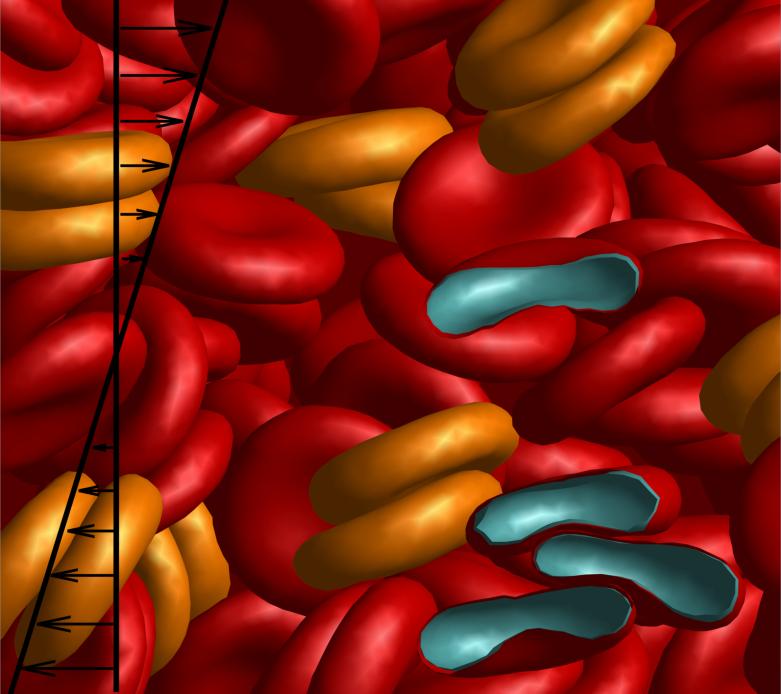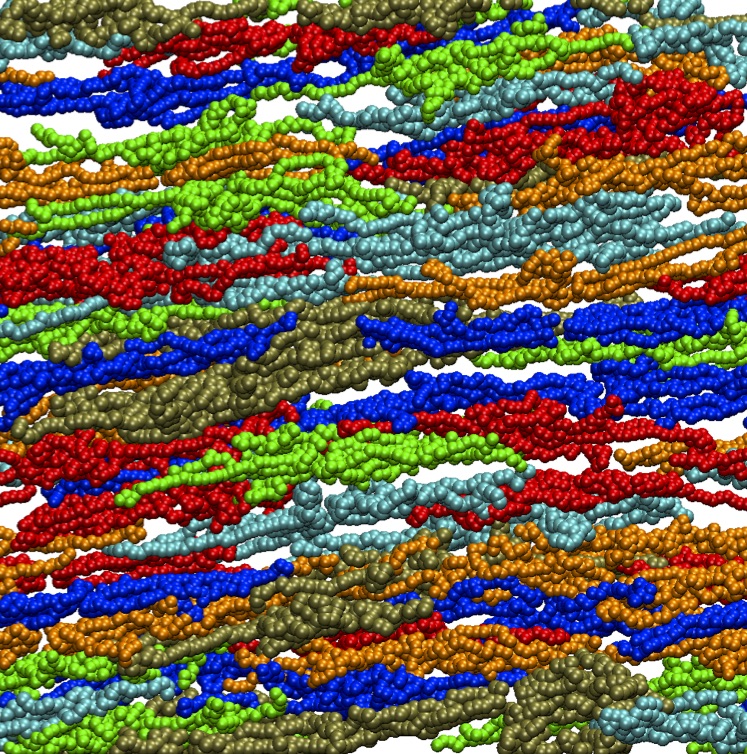Rheology
Rheology of soft-colloid suspensions plays an important role in a large range of applications. Soft colloids comprise a wide class of materials, ranging from linear polymers over polymeric assemblies, such as star polymers and dendrimers, to vesicles, capsules, and even cells. Suspensions of such colloids exhibit remarkable responses to imposed flow fields. This is related to their ability to undergo conformational changes and viscoelastic deformations, and the adaptation of their dynamical behavior.
Blood rheology

The viscosity of blood has long been used as an indicator in the understanding and treatment of disease. However, a connection between macroscopic rheology of blood and the behavior and properties of single blood cells and biomolecules is still not fully understood. Numerical simulations of blood rheology allow us to establish the link between bulk properties of blood and its microstructure and dynamics of single RBCs. Our recent study shows that blood shear-thinning is the result of a rich dynamic behavior of RBCs convoluted with a large distribution of shapes for any given flow condition. For increasing shear stresses, RBCs will successively tumble, roll, deform into rolling stomatocytes and finally adopt highly deformed and polylobed shapes without clear tank-treading of their membrane. Furthermore, simulations lead to the first quantitative estimates of the magnitude of aggregation forces between RBCs.
- L. Lanotte, J. Mauer, S. Mendez, D. A. Fedosov, J.-M. Fromental, V. Claveria, F. Nicoud, G. Gompper, and M. Abkarian, "Red cells' dynamic morphologies govern blood shear thinning under microcirculatory flow conditions", Proceedings of the National Academy of Sciences USA, 113, 13289-13294, 2016.
- D. A. Fedosov, H. Noguchi, and G. Gompper, "Multiscale modeling of blood flow: from single cells to blood rheology", Biomechanics and Modeling in Mechanobiology, 13, 239-258, 2014.
- D. A. Fedosov, M. Dao, G. E. Karniadakis, and S. Suresh, "Computational biorheology of human blood flow in health and disease", Annals of Biomedical Engineering, 42, 368-387, 2014.
- D. A. Fedosov, W. Pan, B. Caswell, G. Gompper, and G. E. Karniadakis, "Predicting human blood viscosity in silico", Proceedings of the National Academy of Sciences USA, 108, 11772-11777, 2011.
Rheology of star-polymer solutions

Star polymers consist of a number of identical linear polymer chains (or arms), which are linked at one of their ends to a common center. By changing the arm length and the functionality (the number of arms), star-polymer properties can be varied between linear polymers to nearly hard-sphere colloids (large functionality, short arms) and ultra-soft colloids (intermediate functionality, long arms). Thus, the rheological properties of star-polymer solutions are expected to show a rich and diverse behavior. We investigate the rheological behavior of semidilute star-polymer solutions in shear flow. The structural and rheological properties exhibit a universal behavior as function of a concentration-dependent Weissenberg number for various concentrations at a given arm length. The rheological properties are characterized by the shear viscosity and the normal-stress coefficients.
- R. G. Winkler, D. A. Fedosov, and G. Gompper, "Dynamical and rheological properties of soft colloid suspensions", Current Opinion in Colloid and Interface Science, 19, 594-610, 2014.
- R. G. Winkler, S. P. Singh, C.-C. Huang, D. A. Fedosov, K. Mussawisade, A. Chatterji, M. Ripoll, and G. Gompper, "Mesoscale hydrodynamics simulations of particle suspensions under shear flow: From hard to ultrasoft colloids", European Physical Journal-Special Topics, 222, 2773-2786, 2013.
- D. A. Fedosov, S. P. Singh, A. Chatterji, R. G. Winkler, and G. Gompper, "Semidilute solutions of ultra-soft colloids under shear flow", Soft matter, 8, 4109-4120, 2012.
- S. P. Singh, D. A. Fedosov, A. Chatterji, R. G. Winkler, and G. Gompper, "Conformational and dynamical properties of ultra-soft colloids in semi-dilute solutions under shear flow", Journal of Physics: Condensed Matter, 24, 464103, 2012.